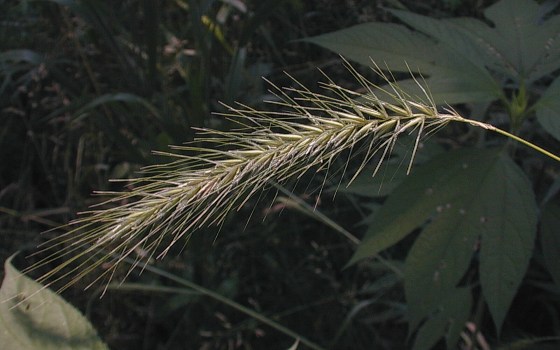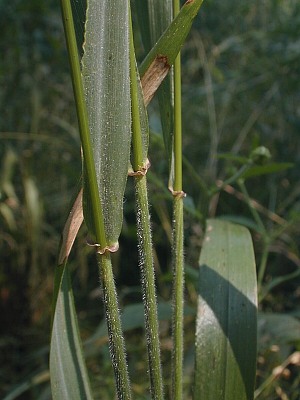Description: This perennial grass is 2½–3½' tall and unbranched, often forming tufts of culms at the base. Each culm is green, glabrous, and terete (round in cross-section). The blades of the alternate leaves are up to 9" long and nearly ½" across; they are linear, dark green, and slightly hairy. The leaf sheaths are green, finely ribbed, and covered with spreading white hairs. The apex of each sheath wraps tightly around the culm, where there is a pair of auricles (ear-like extensions of the sheath).

Each culm
terminates in a nodding raceme of spikelets about 3-4" long. The base
of each spikelet consists of a pair of narrowly linear and awned glumes
about ¾–1" long (including their awns) and up to 1 mm. across; they
spread outward, giving the inflorescence a bristly appearance. Above
the glumes, there are 1-2 pairs of linear and awned lemmas; these
lemmas are about 1¼–1½" long (including their awns). Each fertile lemma
has a membranous palea about ¼" long that encloses the developing
grain. Both the glumes and the lemmas are more or less covered with
patches of fine hairs. The spikelets are whitish green while the
flowers are in bloom, and shortly later they become tan. The blooming
period occurs during the summer. Each spikelet produces 1-2 elongated
grains. The root system is fibrous.
Cultivation:
The preference is partial sun to light shade, moist to slightly dry
conditions, and a fertile loamy soil.
Range & Habitat:
Silky Wild Rye is a common grass that occurs in every county of
Illinois (see Distribution
Map). Habitats include deciduous woodlands, woodland borders,
rocky wooded slopes, savannas, small meadows in wooded areas, and
thickets. This grass is usually found in higher quality wooded
habitats.

Faunal Associations:
The flowers are wind-pollinated and attract few insects. The
caterpillars of the moth Leucania pseudargyria
(False Wainscot) and the leafhopper Laevicephalus orientalis
feed on Elymus spp. (Wild Ryes). Birds apparently
pay little attention to the seeds as a food source. Livestock eat the
foliage of Wild Ryes, but the awns of the seedheads can cause
mechanical injury to their mouthparts and gastrointestinal tracts.
Photographic Location:
Along a path in a wooded area of Meadowbrook Park in Urbana, Illinois.
Comments:
Silky Wild Rye is an attractive woodland grass. It is one of several Elymus
spp. (Wild Ryes) in Illinois. As a group, these grasses have
large bristly inflorescences; they are cool-season grasses with a C3
metabolism, maturing by mid-summer. Silky Wild Rye can be distinguished
from Elymus virginicus (Virginia Wild Rye) by its
nodding inflorescence; the latter has an erect inflorescence.
Similarly, Silky Wild Rye can be distinguished from an uncommon
species, Elymus riparius (Riverbank Wild Rye), by
its hairy sheaths; the sheaths of the latter species are hairless.
Another species, Elymus canadensis (Canada Wild
Rye), is a more robust grass that has broader glumes (often 1.0–2.0 mm.
across), while the glumes of Silky Wild Rye are 1.0 mm. across or less.
There is a rare form of Silky Wild Rye, f. arkansansus,
that has hairless lemmas.